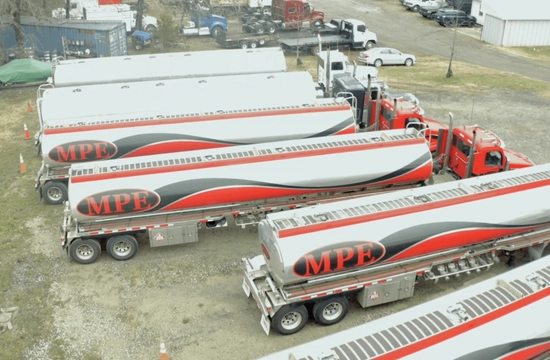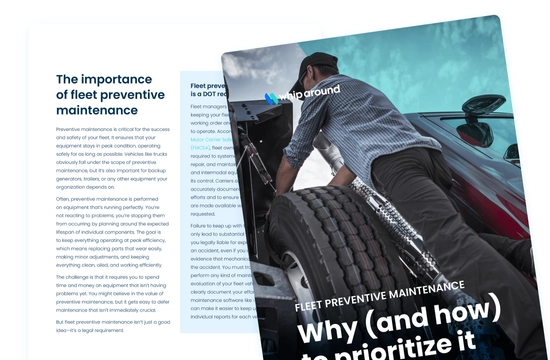- SolutionsMaintenance
Fleet maintenance software for vehicles and equipment
ComplianceEverything you need to keep your fleet compliant with the DOT
InspectionsVehicle inspection software that keeps you compliant and cuts costs
ReportingAccess the vital data you need to optimize the performance of your fleet
Fuel ManagementTrack fuel usage in real time and maximize profitability through fuel cost tracking
IntegrationsSee all - CustomersFeatured Case StudiesSee all
![Spartan Logistics]() Spartan Logistics
Spartan LogisticsSpartan Logistics is a safer, more efficient business by keeping their maintenance up and costs down with Whip Around.
View case study![Monster Tree Service]() Monster Tree Service
Monster Tree ServiceWhip Around gives Monster Tree Service visibility on vehicle & equipment location, condition, what work is due and what has been completed
View case study![Northwest Repossession]() Northwest Repossession
Northwest RepossessionNorthwest Repossession saves tens of thousands of dollars every year by staying totally compliant with Whip Around.
View case study![M. Pittman Enterprises]() M. Pittman Enterprises
M. Pittman EnterprisesThe team at M. Pittman turned to Whip Around for a digital solution to take the guesswork out of their preventive maintenance process.
View case study - ResourcesFeatured ContentSee all
![eBook: Fleet preventive maintenance: Why (and how) to prioritize it]() eBook: Fleet preventive maintenance: Why (and how) to prioritize it
eBook: Fleet preventive maintenance: Why (and how) to prioritize itEverything you need to make preventive maintenance a priority for your fleet.
View eBook![eBook: Creating a preemptive culture of safety, compliance, and preventive maintenance]() eBook: Creating a preemptive culture of safety, compliance, and preventive maintenance
eBook: Creating a preemptive culture of safety, compliance, and preventive maintenanceHow to build a preemptive culture of safety in six steps.
View eBookResource Type - Pricing
How to Create a Fuel-Efficient Fleet

The Importance of a Fuel-Efficient Fleet
Establishing and maintaining a fuel-efficient fleet is essential to the overall success of any trucking business. Not only will fuel efficiency affect the company’s bottom line, but it will inherently improve the longevity of each rig. Taking stock of the current fuel efficiency of the fleet, implementing a system to remain current on maintenance and repairs and closely monitoring fuel consumption through regular reporting will help ensure any fleet remains running on all cylinders.
1. Assess the Current Fuel Efficiency of Your Fleet
Step one to ensure your fleet is running at optimal fuel efficiency is to assess how the fleet is performing at baseline. Tracking fuel consumption and mileage is best accomplished through the consistent and accurate use of a fleet management software system. Beyond simply tracking how much fuel is consumed by the fleet and miles driven, using this data to inform decisions regarding all things fuel is how to improve fuel efficiency. Key areas to assess include:
- Fuel Purchase Management. Centralized fuel purchasing with established controls will facilitate the identification of cost-saving opportunities and supplier comparisons. Data related to when and where fuel is purchased will inform decisions such as the best supplier, and best/worst times to refuel. Monitoring price changes in fuel will ensure fuel is purchased at optimal times and when compared to the prior year can aid in identifying trends.
- Driver Behavior. Telematic systems provide data such as speeding, excessive stops, idle time, and routes impacting fuel efficiency. Practicing safe and efficient driving behaviors such as the use of cruise control, and reduction in rapid acceleration and/or braking prevents excess fuel usage. For example, pumping the gas and brake pedal in quick succession can lower the rig’s mpg by 15 to 30 percent on the highway or 10 to 40 percent in traffic. Studies have concluded that a rigorous driver’s training program can reduce fuel usage by as much as 20%. Driver theft is another place where funds can be lost. Unfortunately, not every driver is going to be honest and some drivers may use company funds to buy fuel for things other than the company vehicle. To avoid losing company money on driver theft it is important to monitor fuel consumption.
- Route Optimization. Planning is key to route optimization. Bypassing congested areas, adjusting drive times, minimizing stops, and listening to the radio for any roadblocks ahead will optimize the route, thus reducing fuel consumption. When choosing the route, drivers must consider distance vs efficiency, idle time vs. drive time, and mpg on rougher terrain. Weather and road conditions also affect fuel consumption as spinning wheels with no traction waste fuel. Drivers can avoid this by adjusting drive times, and routes or coming prepared with salt and accelerating slowly.
- Vehicle Maintenance and Repair. Assessing the fleet’s current status with regard to maintenance and repairs will reveal areas for fuel efficiency improvement. Something as simple as a few pounds of tire pressure or as involved as faulty equipment will each have an impact on the overall fuel efficiency of the fleet. Monitoring fuel efficiency trends is a major benefit to vehicle maintenance. This allows management to spot changes in the trend that may be tied to maintenance issues.
2. Maintain and Optimize Your Fleet
Keeping up with regular maintenance and inspections is a must when it comes to creating and maintaining a fuel-efficient fleet. Performing regular maintenance and remaining current on inspections is best managed through the use of vehicle fleet maintenance software. Below are listed basic, yet all-important standard maintenance requirements:
- Tire Pressure. Maintaining the recommended tire pressure can improve mileage by up to 3%, per the EPA.
- Engine Tune-Up. Whether it’s replacing spark plugs and filters or performing more involved engine repair, a smoothly running engine can improve mpg by up to 40%!
- Wheel Alignment. Besides preventing irregular wear on the tires, correctly aligned wheels will improve mpg.
- Oil. Regularly scheduled oil changes using the manufacturer’s recommended product is truck maintenance 101. The oil that boasts the “energy conserving” API symbol is even better for fuel conservation.
- Fault Identification and Repair. Correcting faults ASAP not only improves fuel efficiency but also avoids costly compliance issues and emission standards.
The beauty of having a fleet maintenance program that utilizes software for fleet maintenance is that the fleet maintenance manager is not only able to remain current on fleet maintenance and repair but is also able to record data and use it in a variety of ways to improve the overall use of resources.
3. Monitor Fuel Efficiency Through Regular Reporting
Tracking progress is the only way to create a fuel-efficient fleet. Without this key step, a fleet maintenance manager will struggle because in any business, the future is formed by understanding the past and making informed decisions to create a better future. The best way to track fuel usage, driver behavior, maintenance and repair schedules, licensure and compliance documents, and dates is through the use of powerful yet easy-to-use software for fleet management.
As the Fleet Maintenance Manager gathers data and tracks progress, the best fleet maintenance software will generate highly customized reports, graphs, and charts. These fuel efficiency reports can then be easily shared with stakeholders such as management, drivers, and customers. Keeping the key players apprised of the progress that is made maintains their vested interest and participation in efforts toward the goal of overall optimal fuel efficiency.
Increase Your Fuel Efficiency with These Tips
To achieve a fuel-efficient fleet, the use of fleet management software is crucial. It helps in accurately evaluating the current fuel efficiency and optimizing fleet operations by properly maintaining and repairing equipment. Additionally, regular monitoring of fuel efficiency through data-driven reporting over time can further enhance the fleet’s fuel efficiency.
One such software is Whip Around, the easy-to-use fleet preventative maintenance software for drivers, mechanics, and managers. Now is the time to implement these recommendations in creating a dominant fuel-efficient fleet.









